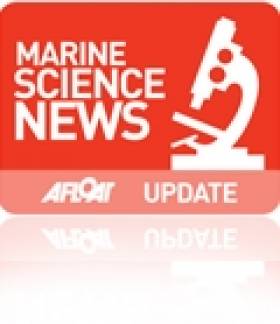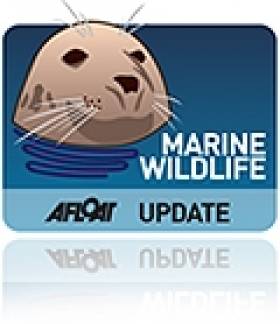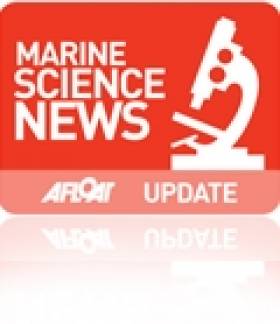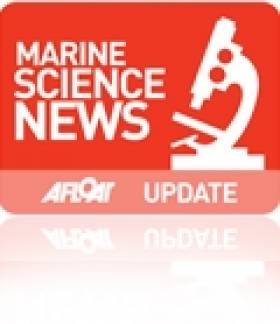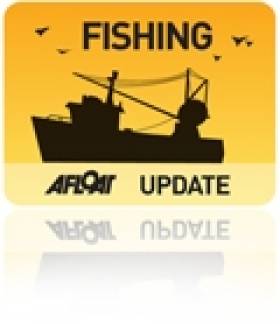Displaying items by tag: marine science
Marine Scientists Gather in Dublin on Sustainable Use of Seas
#marinescience – Educators, trainers, European Commission members, and marine and social scientists from 11 countries across Europe met in Dublin in January for an important meeting of the Sea For Society project which aims to develop a sustainable relationship between humankind and the oceans.
The Sea For Society project is funded through the European Commission's Seventh Framework Programme (FP7). The project's 28 partners represent universities, funding agencies, government marine research organisations, NGOs, business networks, science museums and aquaria, and the media.
For the first time, the project aims to bring together a wide range of participants (stakeholders, citizens and youth) across Europe to examine the issues surrounding the development of a new concept for sustainable use of the seas called "the Blue Society". This concept explores how humankind can coexist with, and benefit from, the oceans without harming them.
Sea For Society Project Manager, Ludovic Frère Escoffier, of the Nausicaá aquarium in Boulogne-sur-Mer, France, said that the Blue Society was founded on "an unprecedented economic, technological and social approach which involves taking advantage of new resources, innovative solutions and positive experiences that the oceans offer".
The aims of the Sea For Society project will be accomplished through a series of forums held in nine European countries and will involve key stakeholders, youth and citizens. Each forum meeting will be based on a mutual learning, open-dialogue process, bringing together researchers, the general public and other actors to consider one of six allocated themes regarding what the sea provides to human beings in their daily lives: food supply, human health, a place to live, transport, energy, and leisure and tourism. The results of these consultations will be the basis of a European mobilisation towards a "Blue Society".
"As a result of this process, citizens, including young people, stakeholders, marine experts and scientists will all learn from each other and, in turn, the Sea For Society project will learn from these groups," said Dr. Christine Domegan, Senior Lecturer in Marketing at NUI Galway, who has been working on the methodology of the consultation process alongside Dublin-based project partner AquaTT.
The forums will use a facilitation process called Collective Intelligence, an idea and value structuring methodology that helps groups to deal with complex issues. To instruct project partners on how the Collective Intelligence consultations could be effectively carried out, Professor Benjamin Broome of the Arizona State University and Dr. Michael Hogan of NUI Galway conducted a two-day practical workshop as part of the Dublin meeting.
The workshop was followed by a day-long partnership meeting of all participating groups, and a half-day workshop on communications for the project.
'Frontier' Surveyors Meet Sperm Whales and Killer Whale
#MarineWildlife - Sperm whales and a killer whale were among the finds on the last big effort of this year's Cetaceans on the Frontier survey led jointly by the Galway-Mayo Institute of Technology (GMIT) and the Irish Whale and Dolphin Group (IWDG).
As previously reported on Afloat.ie, marine scientists from GMIT's Marine and Freshwater Research Centre are on board the RV Celtic Explorer to carry out the fourth dedicated survey of cetaceans on the continental shelf edge.
The ship was surveying a zig-zag pattern in the Atlantic yesterday 2 February, some 55 nautical miles west-by-northwest of Achill Island (visible on this map HERE) when the team encountered at least two sperm whales, though an elusive third may also have been present - as indicated by the hydrophone being towed 200m behind the vessel.
"The blows continued and as we got closer, more and more body of the surfacing whale could be seen until we were treated to some reasonable views of the steep nose, long flat back and stumpy dorsal fin on initial surfacing followed by a thick tail stock with ‘knuckles’ seen when flaking," writes Niall Keogh on the Cetaceans on the Frontier blog.
Soon after that, the researchers were treated to their first sight of a killer whale in Irish waters - followed by a number of pilot whales surfacing close to the ship.
Marine Institute Invites Applications for Summer Work Placements
#MarineScience - The Marine Institute is inviting students to apply for a number of work experience placements in many exciting areas for this summer 2013.
The list and short description of the positions (available in a Word doc HERE) include 26 placements for 15 work titles.
The bursaries are worth €2,200 each for an eight-week placement based in various locations including the Marine Institute in Oranmore, Co Galway; Newport, Co Mayo; Harcourt Street in Dublin; and ports around the country.
The Marine Institute’s Bursary Programme provides valuable practical experience for budding marine scientists in areas of research such as marine fisheries, salmon management, aquaculture, environment, communications and the library.
The Bursary Programme is aimed at undergraduates of universities, institutes of technology and national institutes for higher education. The scheme is strictly limited to undergraduates who have completed two years' study in a relevant discipline.
Previous bursars have gone on to work in the Marine Institute (including two directors of the institute), Bord Iascaigh Mhara (BIM), regional fisheries boards, county councils, pharmaceutical companies and State laboratories, with some going as far afield as the EPA in Sydney, Australia and some now running their own companies.
To apply for the Summer Bursary Programme:
- Please check out the 15 bursary titles on offer (via the link above)
- Select the two bursaries that interest you most and in order of preference
- Complete the Marine Institute Bursary Application Form 2013 and return it FAO Annette Jordan, Marine Institute, Furnace, Newport, Co Mayo
The deadline for receipt of applications is 8 February 2013.
Opportunity For a Director With The Marine Institute
#Jobs - The Marine Institute is seeking applicants for the position of Director of Marine Environment & Food Safety Services.
The director will lead an experienced team responsible for the delivery of a number of critical functions in support of seafood safety, fish health and the protection of the marine environment.
The successful candidate will work closely with Government departments, external parties and key stakeholders in the effective management of scientific services and provision of policy advice.
The director will also provide strategic direction in the targeting and management of competitive research projects funded nationally and internationally.
Candidates will have successfully managed programmes, people and resources at a senior and strategic level. You will be able to demonstrate relevant experience and qualifications as detailed in the job specification to include a primary degree complemented by at least seven years post-qualification work experience.
A detailed job description can be found at the Marine Institute website HERE. The closing date for receipt of applications is 5.30pm on Tuesday 5 February 2013.
The Marine Institute is an equal opportunities employer.
Research Vessel Explorer Departs on Dolphin Survey Mission
#marinescience – Scientists from GMIT's Marine and Freshwater Research Centre will depart Galway today on board the RV Celtic Explorer to carry out the fourth dedicated survey of cetaceans on the continental shelf edge. The trip will determine if a distinct population or 'eco-type' of bottlenose dolphin exists in offshore waters, as suggested by DNA analysis, photo-identification and behavioural traits observed in previous surveys.
'Cetaceans on the Frontier,' an annual research cruise since 2008, lead jointly by Galway-Mayo Institute of Technology (GMIT) and the Irish Whale and Dolphin Group (IWDG) records the number and distribution of whales, dolphins and porpoises along the continental shelf edge. The region is an important habitat for cetaceans because of the rich food resources available from increased productivity caused by upwelling when nutrients are brought to the surface from the depths.
This project aims to identify particular areas of importance for cetaceans as well as other species such as seabirds, with this survey focusing in particular on the bottlenose dolphin.
GMIT Marine Scientist and lecturer Dr Joanne O'Brien, says: "While many people are familiar with coastal bottlenose dolphins that are resident in the Shannon Estuary, or those which occasionally venture into bays and harbours during summer months, little is known about their offshore counterparts."
Mr Conor Ryan, the chief scientist on this survey, and member of the Irish Whale and Dolphin Group, says, "The bottlenose dolphin is required to have strict protection under the EU Habitats Directive but this is difficult to achieve for animals living offshore as we know little about their ecology, movements and the threats that they may face."
"As in 2012, we will take skin samples from these dolphins by deploying a small boat from the Celtic Explorer using a biopsy darting system to collect skin samples for DNA analysis, under licence from the National Parks and Wildlife Service. We will photograph their uniquely marked dorsal fins and catalogue individuals' movements. We also hope to characterise their preferred habitat type, e.g. their preferred depth and distance from the shelf edge."
Cetaceans on the Frontier is an inter-disciplinary research cruise, and scientists specialising in seabird biology, plankton and micro-plastics will also be collecting data in order to determine how different species are interacting with their environment and with each other. Last year the bird team recorded a rare black-browed albatross, tens of thousands of kilometres from its native Southern Ocean.
The micro-plastics research team, based in GMIT, aims to investigate how prolific plastic pollution is in the ocean, particularly in deep waters far from the sources of dumping. Zooplankton (including jellyfish such as the mauve stinger) will be collected in small nets and analysed for chemical tracers called stable isotopes which help ecologists to model food-webs including the diets and even movements of larger predators such as fish, birds and cetaceans.
Scientists from GMIT, IWDG, BirdWatch Ireland, Queens University Belfast, National Oceanographic Centre Southampton, University College Cork and University of La Rochelle will spend two weeks at sea, zig-zagging along the shelf edge from Co. Donegal to Co. Cork. The survey is funded through the Marine Institute's National Research Vessel Ship –Time Programme 2013 supported by the Marine Research Sub-programme of the National Development Plan 2007–2013.
Illustrated Talks On Shannon's Natural Heritage Throughout February
#Shannon - MulkearLIFE and Inland Fisheries Ireland have announced details of a series of free illustrated talks taking place in Limerick throughout February on the extraordinarily rich natural heritage of Ireland, and in particular the Lower Shannon.
The talks form part of MulkearLIFE’s Environmental Education Programme, an outreach programme in local schools and the local community in the Mulkear catchment. The series will be hosted over four Tuesday evenings and will include leading experts sharing their knowledge on farming and conservation and biodiversity management.
Among the talks will be the fascinating story of Atlantic salmon in the River Shannon, presented by Dr Phil McGinnity on 12 February. Dr McGinnity is Beaufort Principal Investigator with UCC’s Aquaculture & Fisheries Development Centre, with more than 23 ears of experience in fisheries science and management, and his talk will outline new and extremely exciting research on the genetic make-up of various salmon types found in the Shannon. He will also examine the history of salmon fisheries on the Shannon. His talk should be of particular interest to anglers far and wide and anyone with a general interest in Irish biodiversity.
On 19 February, Colette O’Flynn will relate the scary story of what is emerging in terms invasive non-native animals and plants arriving into Ireland's coastal and inland waterways. O’Flynn is a research officer with the National Biodiversity Data Centre in Waterford. She manages the National Invasive Species Database for Ireland, which tracks non-native invasive animals and plants in Ireland. She is involved with many European and international invasive species information networks and has been involved with invasive species policy development for the European Commission. She previously worked in various areas in biodiversity education and awareness. Her talk should be of interest to a wide variety of people, especially anglers and those with an interest in Irish wildlife and general biodiversity.
The series of illustrated talks will conclude on 26 February with a talk by Eamon Cusack on building partnerships for sustainable fisheries on the Lower Shannon. Cusack is extremely well known in the fisheries world with over 35 years experience in inland fisheries management. As the former CEO of the Shannon Regional Fisheries Board, he encountered many of the challenges facing fisheries management, and has hands-on experience of policy development, strategic management, change management, enforcement, development and rehabilitation. This talk will focus on his recent work to bring together anglers and the ESB to provide to build effective and durable partnerships for sustainable fisheries. His talk should be of particular interest to local anglers and anyone with a general interest in conservation management and planning.
But the series begins on 5 February with a talk presented by Ruairí Ó Conchúir on conservation farming and biodiversity in the Upper Mulkear Catchment. Ó Conchúir is the manager of MulkearLIFE and has worked in land care management, rural development, farming for conservation and fisheries restoration work for over 20 years, including 10 years in Southern Africa. His talk will focus on the work of MulkearLIFE with farmers over the past three years, with a particular emphasis on partnership work with farmers to improve local habitats. The talk will also attempt to map out where upland farming in Ireland is heading and review work in other uplands parts of Ireland, and outline the likely implications are for upland communities, related farming and habitats post 2014. His talk should be of particular interest to anyone with a general interest in farming, the Irish uplands and the future of EU agri-environmental supports post 2014.
The venue for all talks is the Inland Fisheries Ireland office at Ashbourne Business Park, Dock Road, Limerick. There is plenty of free parking at the front of the building at night. Talks will commence at 8pm sharp and there is free admission to all talks. Further information regarding any of the talks may be obtained from the project [email protected] or from MulkearLIFE, Inland Fisheries Ireland (Limerick) at 061 300 238 or 087 062 5582.
Live Giant Squid Filmed For First Time
#MarineWildlife - The video above is a world first for marine biology - the first known footage of a living giant squid in the ocean.
The remains of the elusive beast have been captured before, but news has now come out that a team of marine scientists finally recorded video of a living specimen deep below the surface off Japan's Ogasawara islands.
As RTÉ News reports, last July the team - working on a documentary for Discovery and Japanese TV network NHK - used a small submersible equipped with near-infrared lights invisible to both squid and human eyes.
After 100 attempts, they finally attracted the attention of a three-metre long cephalopod - small by giant squid standards, but the largest ever seen alive.
"It was stunning." said zoologist and team leader Tsunemi Kubodera. "I couldn't have dreamt that it would be so beautiful. It was such a wonderful creature."
The documentary Monster Squid: The Giant Is Real will be broadcast on the Discovery Channel in the US on 27 January, and hopefully will appear on Discovery UK & Ireland soon after.
Marine Agriculture Could Be Answer To World Hunger Problem
#MarineScience - With world hunger set to be a hot button issue at the G8 summit in Northern Ireland this summer, the Guardian reports on one possible solution to the problem of food scarcity in the developing world in the form of marine agriculture.
Water scarcity is "the most severe impediment to increasing food production and security", particularly in regions like the Sahel in West Africa, where irrigation is not a practical option and dry seasons often ruin traditional rain-fed harvests.
But water scientist Ricardo Radulovich of the University of Costa Rica posits a novel approach - take advantage of Africa's lakes, many of which cover a large surface area, by using the water surface to grow crops and farm fish.
A prototype project in Nicaragua has produced crops of fruit and vegetables on floating rafts which can be made cheaply from various everyday materials.
Radulovich and his team also talk up the benefits of cultivating water-borne plants normally considered weeds, such as water hyacinth, to encourage biodiversity and attract bigger fish to areas with poor numbers.
The Guardian has much more on the story HERE.
New Survey Technology Shines Light on Donegal Shipwrecks
#marinescience – A survey by a Marine Robotics Team from University of Limerick (UL) using the UL built Smart ROV Latis has shed new light on two shipwrecks off the coast of Donegal, the S.S. Empire Heritage and the S. S. Empress of Britain.
The survey onboard the RV Celtic Explorer led by Dr. Daniel Toal, University of Limerick (UL) captured photo images as well as multi-beam sonar images at two archaeological sites. The survey planning drew on the knowledge of technical diver Dr Ger Dooley, a member of the survey team who has dived on many wrecks on the northern approaches off the Donegal Coast.
High resolution sonar imaging was used to create new images of the S.S. Empire Heritage, a cargo ship which had been carrying dozens of Sherman Tanks when it was torpedoed and sank in 1944 with the loss of 113 lives. New images of the S. S. Empress of Britain, a passenger liner, thought to have been carrying gold when it sank in 1940 were also created.
The S. S. Empire Heritage now lies at a depth of 70 metres, 15 miles north-west of Malin Head and the survey captured images of the cargo of tanks, originally destined to fight in WWII, now scattered across the seafloor.
High resolution image of the S.S Empress of Britain
The S. S. Empress of Britain, a 42,000 ton, 230 m passenger liner lies at 160 metres, 40 miles north-west of bloody foreland and is believed to be the largest ship sunk by a U-boat. A salvage operation carried out on the wreck in 1995 on suspicion that the ship had been carrying a large cargo of Gold from Africa destined for America reported finding the Empress upside-down in 500 feet of water. The salvagers reported breaking into the strong room only to find a single skeleton and no gold. It was suspected the gold was unloaded while the Empress was on fire and its passengers were being evacuated. However, the high resolution sonar image which was taken during the recent ROV dive shows the wreck listing on its side, not upside-down as reported by the earlier salvage operation.
High Resolution image of the S.S. Empress of Britain
The aim of the survey was to trial ROV technology developed by UL for a variety of marine applications including high resolution sonar imaging of ship wrecks for archaeological records, demonstration of ROV Latis' precision underwater navigation and dynamic positioning capabilities to the Irish Coast Guard for Search and Rescue, as well as trialling a 'daughter ROV' or 'fly-out out mini ROV' for hull penetration and internal inspection where the larger ROV Latis cannot venture.
Dr Toal explained "In order to acquire high resolution sonar images the sonar instruments must be flown close to the ship wreck. Building a composite sonar image of a wreck with large numbers of sonar pings requires precise knowledge of the position and orientation of the ROV platform during the imaging transect. The ROV Latis is equipped with state of the art under water positioning, navigation and auto pilot control systems which makes it an ideal platform for this high resolution survey work."
When poor weather conditions during the six day survey prevented operation of the ROV, the team moved to the sheltered waters of Lough Swilly where they tested a new low cost terrain referenced navigation system for unmanned vehicles developed by the Marine Robotics Research Centre at UL.
The survey was supported by the Marine Institute through the 2012 Ship Time Programme as part of the Sea Change Programme funded under the National Development Plan 2007 -2013. The shipwrecks surveyed were previously mapped from the sea surface by the Geological Survey of Ireland and Marine Institute during the INSS and INFOMAR national seabed mapping programmes.
Further details and information on the shipwrecks are available in the new book published this week by government publications, entitled "Warships, U-Boats & Liners".
Unfishable Areas May Be Refuge for Endangered Flapper Skate
#FISHING - Marine scientists working in the Celtic Sea have discovered a natural refuge for the critically endangered flapper skate.
Many elasmobranchs (sharks, rays and skates) are highly vulnerable to over-fishing, but a new paper in the open access journal PLOS ONE shows that small areas of the seabed that experience below-average fishing intensity can sustain greater populations of these species.
The study reveals that one remarkable area in the northeastern Celtic Sea - where uneven seabed makes trawling difficult - supports at least ten species of elasmobranch, including the rare blue skate (Dipturus flossada) and related flapper skate (Dipturus intermedia).
Dipturus was previously considered to represent a single species (D. batis), but made the news in 2009 when a case of misidentification was revealed.
Both species are now listed as critically endangered but populations of the flapper skate, which can grow up to 2.5 metres in length, are considered to be under greatest threat from extinction.
European Union regulations mandate that fishermen throw back any flapper skate but its slow growth and reproduction mean that even very low levels of fishing mortality are now unsustainable for this species.
Scientists from Queen’s University Belfast, Bangor University and the Marine Institute carried out the study. Lead researcher Dr Samuel Shephard suggests that “the discovery of a Celtic Sea stronghold for flapper skate provides a remarkable opportunity to help save a species on the verge of extinction”.
Professor Michel Kaiser, chair in marine conservation at Bangor University, added: “Some have previously argued that areas of little interest to the fishing industry are not worthy of conservation, however this study clearly overturns that perception and highlights just how important some of these areas are."
Importantly, the fishing industry has reacted positively to the ‘win-win’ situation that an area of little commercial interest has potential as an important marine reserve.
Professor Dave Reid of the Marine Institute presented the information to industry leaders, and this has led to the inclusion of the area in proposed management plans for elasmobranchs in the Irish and Celtic Seas.
Eibhlín O’Sullivan, CEO of the Irish South & West Fishermen’s Organisation, responded that the Irish fishing industry "has been working with the Marine Institute for the past 18 months on developing a management plan for skates and rays. This new research adds valuable information for the identification of potential seasonally closed areas."
Prof Reid noted that “this is a great model for collaboration on conservation between the fishing industry and scientists”.
The research leading to these results has received funding from the European Community's Seventh Framework Programme (FP7/2007-2013).



























